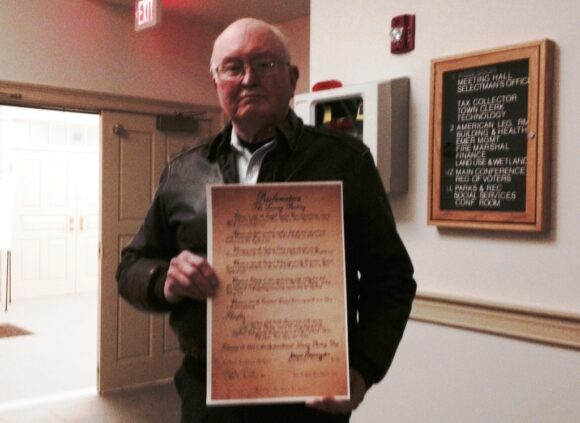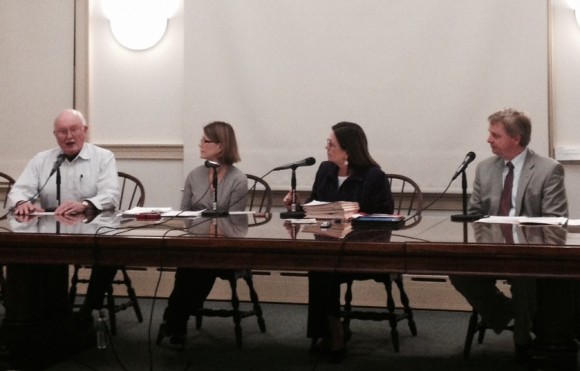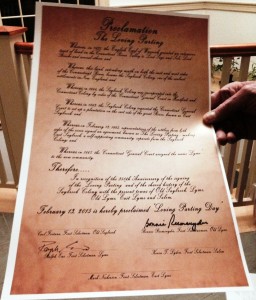
Mark Lander, Co-Chairman of the Old Lyme Historical Society (OLHS), came to Monday night’s Old Lyme Board of Selectmen’s meeting seeking First Selectwoman Bonnie Reemsnyder’s signature on a proclamation announcing Feb. 13, 2015 as ‘Loving Parting Day.’ Reemsnyder duly signed the proclamation following on from Lyme First Selectman Ralph Eno, who had signed earlier in the day.
In a few short weeks, the respective signatures of the First Selectmen of East Lyme, Salem and Old Saybrook will join those of Reemsnyder and Eno on the document and the proclamation will be official.

Lander was invited by Selectman Arthur ‘Skip’ Sibley to explain the history of the five towns that are celebrating the 350th anniversary of the ‘Loving Parting.’ According to the OLHS website, “Initially, Lyme was part of the Saybrook (“Saye-Brooke”) settlement centered on the west bank of the mouth of the Connecticut River. It was established by the Earl of Warwick in 1631, occupied in 1635, and settled and named in 1636.”

Lander noted that the ‘Loving Parting’ was signed on Feb. 13, 1665 as the formal acknowledgement of the separation of the lands on the east bank of the river, which were named after Lyme Regis in England, from the parent Saybrook colony. He commented that the creation of Lyme marked the first time in the state’s history that a town had been formed by splitting it off from another settlement.
The Connecticut General Court named the new plantation “Lyme” on May 9, 1667. Lyme set off the Town of East Lyme in 1839 subsequent to the latter town forming its own church, known as a ‘society.’ It seems likely that East Lyme’s church – the second ‘Society’ – was located on what is now Society Rd. in East Lyme. The first – and original – ‘Society’ in Lyme was what is now The First Congregational Church of Old Lyme.
After East Lyme had formed its own ‘Society,’ Salem followed suit and was also declared a town in its own right. Ironically, the final – and therefore youngest – town of the five to be created out of the lands originally identified in the ‘Loving Parting’ was the one called Old Lyme.
Lander said that in 1854-1855, the town of South Lyme on the shoreline at the mouth of the river was separated from part of the original settlement of Lyme to the north. Noting that there must have been, “Some sort of a disagreement between Lyme and Old Lyme,” Lander said that the residents of the southern area had petitioned for the separation and because the Town of Lyme was the aggrieved party, it was allowed to retain the name of ‘Lyme.’
Although the residents of the new southern portion originally accepted the name of South Lyme for their town, they soon felt, in Lander’s words, that, “It didn’t seem quite right,” and requested – and were approved to make – a change of town name to Old Lyme.
Some local folklore sources say that the choice of the ‘Old Lyme’ name by its residents was a final act of spite against their neighbors to the north in Lyme, who unquestionably lived in the older town! But in 2015, all five towns will come together again as friends to celebrate the ‘Loving Parting.’ The First Congregational Church of Old Lyme will also be hosting a series of events to celebrate 350 years of continuous worship on its site this year.
All in all, 2015 promises to be quite a year for Lyme and Old Lyme!